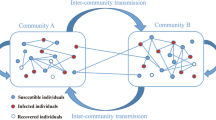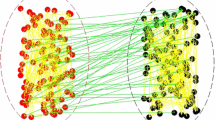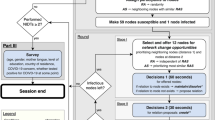Abstract
Contagious diseases spread in population thru the contact network and their spread is a function of the complex interplay of the biological infectivity and behavior of individuals. In this research, we aim to understand how the epidemic dynamics is impacted by the collective behavior of individuals in communities. The stochastic block model is used to generate a community-structured network to investigate the spread of disease using the classical SIR spreading model. We model individual behavior as fear-index that indicates the extent to which an individual follows health and hygiene protocols as a self-protective measure against disease. We observe that the collective behavior of individuals in a community strongly influences the course of an epidemic. Infected individuals with low fear-index rapidly spread the infection within and outside the community. Furthermore, low fear in communities leads to faster growth of the epidemic. We also find that the communities, which comply with the restrictions manifesting high fear level, also suffer the burden of the disease because of non-compliance by other communities (low fear level). Communities with low fear levels are ‘high risk’ groups and should be targeted for awareness campaigns.
Access this chapter
Tax calculation will be finalised at checkout
Purchases are for personal use only
Similar content being viewed by others
References
Wang S, Gong M, Liu W, Wu Y (2020) Preventing epidemic spreading in networks by community detection and memetic algorithm. Appl Soft Comput 89:106118
Chen Y, Paul G, Havlin S, Liljeros F, Stanley HE (2008) Finding a better immunization strategy. Phys Rev Lett 101:058701
Gosak M, Duh M, Markovič R, Perc M (2021) Community lockdowns in social networks hardly mitigate epidemic spreading. New J Phys 23(4):043039
Xu Z, Li K, Sun M, Fu X (2019) Interaction between epidemic spread and collective behavior in scale-free networks with community structure. J Theoret Biol 462:122–133
Barabási AL, Pósfai M (2016) Network science. Cambridge University Press, Cambridge
Keeling MJ, Eames KTD (2005) Networks and epidemic models. J Roy Soc Interface 2(4):295–307
Small M, Cavanagh D (2020) Modelling strong control measures for epidemic propagation with networks—a COVID-19 case study. IEEE Access 8:109719–109731
Stegehuis C, Van Der Hofstad R, van Leeuwaarden JSH (2016) Epidemic spreading on complex networks with community structures. Sci Rep 6:29748
Kitchovitch S, Liò P (2011) Community structure in social networks: applications for epidemiological modelling. PLoS One 6:1–17
Liu Z, Hu B (2005) Epidemic spreading in community networks. Europhys Lett 72(2):315–321
Yu Y, Xiao G (2017) Infection spreading, detection and control in community networks. J Complex Netw 5(4):625–640
Prasse B, Devriendt K, Van Mieghem P (2021) Clustering for epidemics on networks: a geometric approach. Chaos Interdiscip J Nonlinear Sci 31(6):063115
Funk S, Salathé M, Jansen V (2010) Modelling the influence of human behaviour on the spread of infectious diseases: a review. J Roy Soc Interface 7:1247–1256
Gelfand M, Jackson J, Pan X, Nau D, Pieper D, Denison E, Dagher M, Lange P, Chiu CY, Wang M (2021) The relationship between cultural tightness-looseness and covid-19 cases and deaths: a global analysis. Lancet Planet Health 5(3):e135–e144
Gong YW, Song YR, Jiang GP (2014) Epidemic spreading in metapopulation networks with heterogeneous infection rates. Phys A Stat Mech Appl 416:208–218
Steimer T (2002) The biology of fear-and anxiety-related behaviors. Dialogues Clin Neurosci 4(3):231
Coelho CM, Suttiwan P, Arato N, Zsido AN (2020) On the nature of fear and anxiety triggered by covid-19. Front Psychol 11:581314
Huang W, Li C (2007) Epidemic spreading in scale-free networks with community structure. J Stat Mech Theor Exp 2007(1):P01014
Liu T, Li P, Chen Y, Zhang J (2016) Community size effects on epidemic spreading in multiplex social networks. PLoS One 11(3):e0152021
Salathé M, Jones JH (2010) Dynamics and control of diseases in networks with community structure. PLoS Comput Biol 6(4):e1000736
Silk MJ, Carrignon S, Bentley RA, Fefferman NH (2021) Improving pandemic mitigation policies across communities through coupled dynamics of risk perception and infection. Proc Roy Soc B 288(1955):20210834
Holland PW, Laskey KB, Leinhardt S (1983) Stochastic blockmodels: first steps. Soc Netw 5(2):109–137
Abbe E (2017) Community detection and stochastic block models: recent developments. J Mach Learn Res 18(1):6446–6531
Author information
Authors and Affiliations
Corresponding author
Editor information
Editors and Affiliations
Rights and permissions
Copyright information
© 2023 The Author(s), under exclusive license to Springer Nature Singapore Pte Ltd.
About this paper
Cite this paper
Jain, K., Bhatnagar, V., Kaur, S. (2023). Collective Behavior in Community-Structured Network and Epidemic Dynamics. In: Jain, S., Groppe, S., Mihindukulasooriya, N. (eds) Proceedings of the International Health Informatics Conference. Lecture Notes in Electrical Engineering, vol 990. Springer, Singapore. https://doi.org/10.1007/978-981-19-9090-8_16
Download citation
DOI: https://doi.org/10.1007/978-981-19-9090-8_16
Published:
Publisher Name: Springer, Singapore
Print ISBN: 978-981-19-9089-2
Online ISBN: 978-981-19-9090-8
eBook Packages: Computer ScienceComputer Science (R0)




